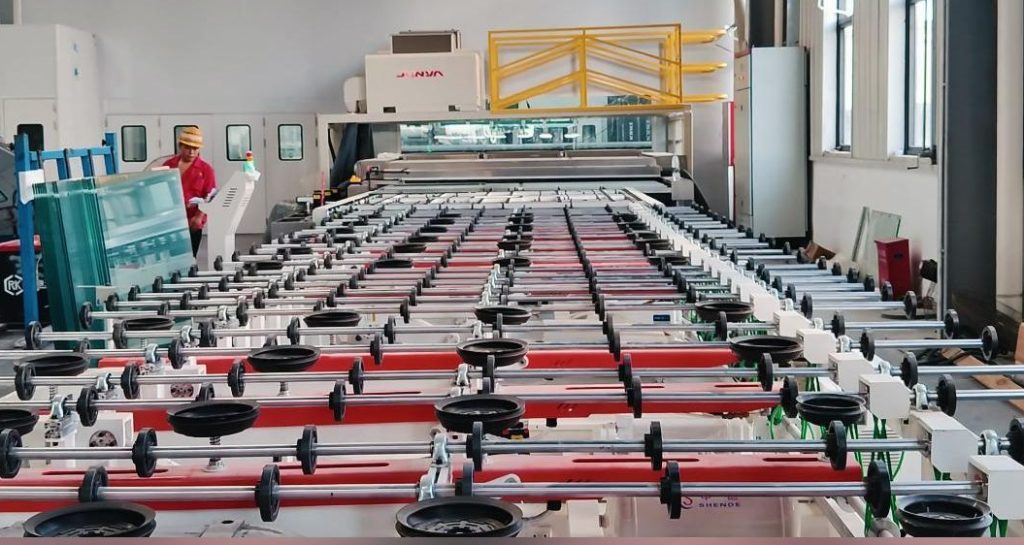
Infrared thermal imaging cameras offer unique advantages in glass production line inspection, such as non-contact measurement, real-time monitoring, and visual representation of temperature data. These features enable precise detection of temperature anomalies at various production stages, enhancing efficiency, ensuring product quality, and reducing operational costs. Here are the key benefits:
- The temperature uniformity of key equipment like glass melting furnaces and heating ovens directly impacts the chemical stability and forming quality of glass (e.g., bubble or streaking defects).
- Infrared thermal imaging provides real-time temperature distribution within furnaces, quickly identifying localized overheating or cooling spots (e.g., temperature differences caused by burner failures or refractory material damage). This prevents composition segregation or forming defects in glass.
Case Study: A float glass production line used thermal imaging to detect abnormally low temperatures at the entrance of a tin bath. Adjusting the heating elements reduced glass flatness defects by 30%.
- Improper temperature gradients during glass forming (e.g., pressing, blowing, drawing) and cooling can cause internal stress concentration, cracking, or optical defects (e.g., uneven stress in tempered glass).
- Thermal imaging rapidly scans surface temperature distributions, visually displaying uniform cooling rates to optimize cooling fan layouts or conveyor speeds and reduce reject rates.
- Mechanical components in glass production lines, such as conveyor motors, reducers, and roller bearings, are prone to overheating due to wear, insufficient lubrication, or abnormal loads.
- Thermal imaging detects component temperatures remotely (e.g., motor casings, bearing housings) and triggers alarms when temperature thresholds are exceeded (e.g., bearings over 80°C), preventing sudden shutdowns that could cause glass melt solidification and costly furnace cleaning (single cleaning costs can exceed ¥100,000).
- Electrical equipment like distribution cabinets, heating element terminals, and variable frequency drives may overheat due to poor connections or aging, risking short circuits or fires.
- Thermal imaging quickly scans all electrical nodes, visually identifying hotspots caused by excessive contact resistance (e.g., terminal temperatures 20°C above ambient), enabling preventive maintenance and reducing production downtime risks.
- Heat loss from high-temperature equipment like melting furnaces and annealing ovens accounts for over 20% of energy consumption in glass production. Thermal imaging detects surface temperature distributions to locate damaged refractory materials or ineffective insulation (e.g., local temperatures 50°C higher than normal), guiding targeted repairs to reduce heat waste.
Data: A company optimized furnace insulation using thermal imaging, saving approximately 15% in annual natural gas consumption and reducing costs by over ¥1 million.
- The fuel-air mixture ratio in burners directly affects combustion efficiency and pollutant emissions. Thermal imaging, combined with temperature data, aids in assessing flame uniformity and combustion completeness (e.g., low flame temperatures may indicate excessive air or poor fuel atomization), optimizing combustion parameters to reduce energy use and NOx emissions.
- Temperatures near glass production line furnaces often exceed 1,000°C. Traditional contact thermometry (e.g., thermocouples) requires close operation, risking burns or splashes from molten glass.
- Thermal imaging completes inspections from meters away, eliminating the need for operators to enter hazardous areas, especially during emergency scenarios (e.g., monitoring furnace leakage precursors).
- Small leaks in natural gas pipelines or cooling water systems are hard to detect visually, but temperature differences at leakage points appear as anomalies in thermal images (e.g., low-temperature water leaks or high-temperature gas leaks).
- Timely detection and resolution of leaks prevent fires, explosions, or equipment corrosion, ensuring safe production line operation.
- Thermal imaging systems store detection images and temperature data. By comparing thermal maps across periods, they analyze equipment temperature trends (e.g., a heating roller’s temperature rising 5°C monthly, indicating potential scaling or insulation aging), enabling "predictive maintenance" instead of reactive repairs.
- Advanced thermal imaging cameras can connect to production line PLCs (Programmable Logic Controllers), automatically triggering alarms, adjusting process parameters, or pausing equipment when temperature anomalies are detected, enhancing production line intelligence.
Infrared thermal imaging serves as a core "sub-health detection" tool for glass production lines. By visualizing temperature data, predicting hazards, and enabling precise maintenance, it not only directly improves product yield and equipment lifespan but also indirectly generates significant economic benefits through energy optimization and safety assurance.

